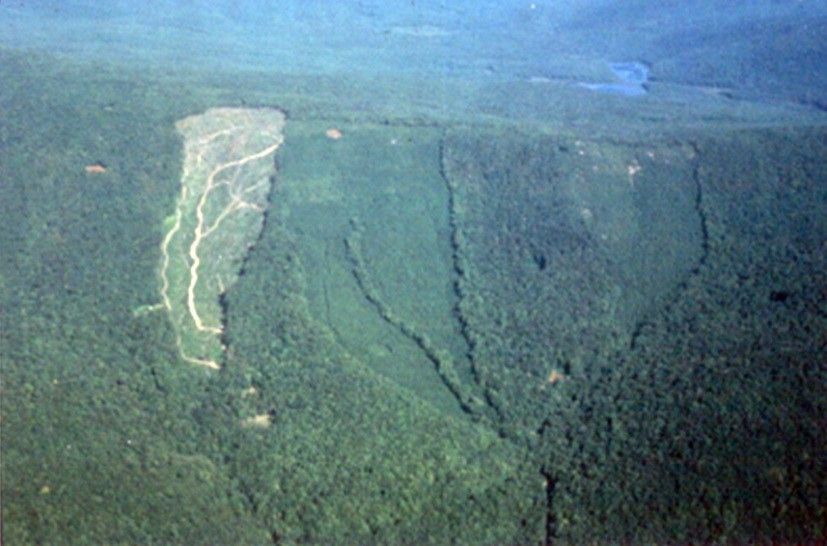understanding deforestation
Scientists at Hubbard Brook were interested in the effects of logging operations on the surrounding ecosystems, and questioned how deforestation would impact biogeochemical cycles and hydrology. Hubbard Brook scientists therefore decided to conduct experiments of deforestation and tree cutting at the watershed level. In December 1965, Watershed 2 of Hubbard Brook was clear-cut and all felled trees were left in place. Herbicide was applied for a 3 year period to prevent regrowth of vegetation. A few years later, Watershed 4 was strip cut in three phases during 1970, 1972, and 1974, and the felled material was removed. Finally, whole-tree harvest was completed in Watershed 5 during 1983-1984, where all biomass was clear-cut and removed. Figure 1 shows an aerial view of some of these deforested or strip-cut watersheds.

Scientists found that these deforestation experiments had a
considerable impact on hydrology and biogeochemistry in
Watershed 2, with similar but reduced impacts in Watersheds
4, 5, and 101. During the three years that Watershed 2 was
devegetated, annual streamflow increased by 40, 28, and 26
percent. With the forest cut down, scientists explain that
this is due to the lack of transpiration of water by vegetation,
which increases the total amount of water available for
streamflow. Scientists also found that about five months
after the deforestation of Watershed 2, large increases in
the stream water concentration of all major nutrients were
observed, except for ammonium, sulfate, and bicarbonate.
The heightened concentration of nitrate, in particular, exceeded
the drinking water standard of 40 mg/L, which can have adverse
health effects, especially for pregnant women and infants.
The increase in concentration of nutrients in
stream water was a result of a disruption of the
nitrogen cycle by deforestation. Normally, when
organic matter falls to the forest floor, microbes
decompose the nitrogen in this dead organic matter
into ammonium and nitrify the ammonium into nitrate.
When plants are present, they reabsorb the ammonium
and nitrate through their roots. However, if trees
are cut down, they cannot reabsorb these nitrogen
compounds, and the compounds are instead released
into stream water. The nitrate ions and hydrogen
ions produced from nitrification, which aren’t
absorbed by plants, further mobilize other ions
through reactions with the soil complex. Figures
2 and 3 provide diagrams of the two nitrogen cycles.


Compared to the reference watershed, Watershed 6,
Watershed 2 also showed acidification of stream
water due to the altered nitrogen cycle caused
by tree cutting, which released more hydrogen ions into streams.
What to look for in this data story
You can see that stream flow increased after
deforestation/tree cutting events in the affected watersheds.
How does the stream flow compare to the inputted
precipitation in these watersheds after deforestation
or tree cutting events?
You can observe that concentrations of some nutrients
increase in stream water after deforestation/tree
cutting events.
How does the concentration of nutrients in stream water
compare to the concentration of these nutrients in
rainwater before and after deforestation or tree cutting
events? Where are these nutrients in the stream water
coming from?
Which nutrients increase in concentration in
stream water after deforestation or tree cutting
events? Which nutrients stay the same in concentration
after these events? Why might that be?
RESOURCES TO LEARN MORE
Free internet resources
From Hubbard Brook Ecosystem Study,
Experimental Watersheds
From Teaching Issues and Experiments in Ecology,
Hubbard Brook Streamflow Response to Deforestation
Books
Holmes, R. T., & Likens, G. E. (2016).
Hubbard Brook: The story of a forest ecosystem.
New Haven: Yale University Press.
Key Papers
Likens, G. E., Bormann, F. H., Johnson, N. M., Fisher, D. W., & Pierce, R. S. (1970).
Effects of Forest Cutting and Herbicide Treatment on Nutrient
Budgets in the Hubbard Brook Watershed-Ecosystem.
Ecological Monographs, 40(1).
Likens, Gene E, F. H Bormann, and N. M Johnson. 1969."Nitrification: Importance To Nutrient Losses From A Cutover Forested Ecosystem". Science 163: 1205-1206.
Pardo, Linda H, Charles T Driscoll, and Gene E Likens. 1995. "Patterns Of Nitrate Loss From A Chronosequence Of Clear-Cut Watersheds". Water, Air, and Soil Pollution 85: 1659-1664.